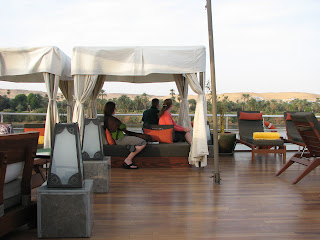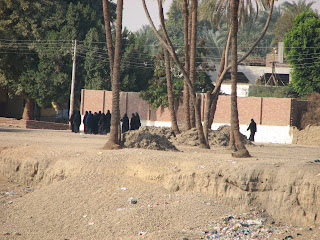
These are the big ones....the ones everyone sees on postcards. The only one of the 7 Wonders of the Ancient World still standing. A few days into Steve and Sara's visit, we drove up to the Giza plateau, stopping on the way to have coffee at the famous hotel, the Mena House. The Mena House lies at the foot of the plateau and has hosted celebrities and heads of states for over a century, most notably Chiang Kai-shek, Churchill, and Roosevelt at their Cairo Conference in 1943.
Sara and Steve agreed to describe this as our house to the folks back home:

A photo from the coffee shop just off the lobby. It has floor to ceiling windows that look out on the pyramids.

Before we head up to the pyramids, I wanted to backtrack for a paragraph. Now the day before, we had visited the pyramid site of Dahshur where the art of building pyramids had progressed from what we had seen at Saqqara and Meidum. The step pyramid at Saqqara was the first manifestation of the idea of building a tomb with height, then came the step pyramid at Meidum which they had tried to fill in with a limestone casing. This outer shell was built at too steep an angle and collapsed as you may remember from our blog entry last month. Enter Dahshur where again the pyramid was built at too steep an angle so partway up they changed the angle, so it is known as the "Bent Pyramid". Sara's pointing out where you can see how the angle changes:

The Bent Pyramid was built by Snefru...the same Snefru who built Meidum. For reasons we can only guess at, he decided to built a third pyramid. Maybe he just wanted to get it right. :) This time he succeeded. It's called the Red Pyramid, from the reddish limestone used in its construction, and it's right next to the Bent Pyramid at Dahshur. Thank you, Steve, for pointing out the first "true" pyramid:

OK, hopefully that wasn't too confusing. Fast forward to Giza. Snefru's son, Khufu, took the advances made by his father and proceeded to construct the largest pyramid of all: the Great Pyramid of Giza. 2.5 million blocks of stone, averaging 2.5 tons each. Our tour guide (that's him on the left in the picture below) pointed out the irony that while Khufu built the largest pyramid of them all, the only representation we have of him is a tiny statuette in the Egyptian Museum, about 7 cm. tall.

The pyramid in the foreground below was built by Khufu's son, Khafre. This is the sole pyramid which still has a remnant of the white limestone casing, giving us an idea of how these pyramids must have gleamed in the sun.

Khafre's pyramid is also the only one which still has an intact valley temple which was pretty cool to see but no pics unfortunately. But here's the remnant of the causeway connecting the valley temple to the pyramid.

The most famous feature of Khafre's pyramid complex is the Great Sphinx, located next to his valley temple. I think I missed her lips. :)


Oh, and I almost forgot....and it was so fascinating too. In 1954, Egypt's President Nasser was driving the King of Saudi Arabia around Khufu's pyramid and the story is that the King noticed that part of the south side of the pyramid was obstructed by a large pile of debris and said something to the effect of "Why don't you have that removed?" Nasser got his Antiquities Dept. on the task and in removing the pile, they uncovered a large pit which contained an entire boat which had been dismantled into 1,244 cedar pieces. This boat was to carry the pharoah into the afterlife. It took a team 14 years to reassemble the pieces and it is now displayed in a small museum next to the pyramid. Amazing!



















































